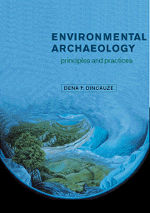Book contents
- Frontmatter
- Contents
- List of figures
- List of tables
- Preface
- Acknowledgments
- Glossary
- PART I INTRODUCTION
- PART II CHRONOLOGY
- PART III CLIMATE
- PART IV GEOMORPHOLOGY
- PART V SEDIMENTS AND SOILS
- PART VI VEGETATION
- 13 CONCEPTS AND METHODS IN PALEOBOTANY
- 14 VEGETATION IN PALEOECOLOGY
- Case Study: The paleoecology of the elm decline
- PART VII FAUNA
- PART VIII INTEGRATION
- References
- Index
14 - VEGETATION IN PALEOECOLOGY
Published online by Cambridge University Press: 20 January 2010
- Frontmatter
- Contents
- List of figures
- List of tables
- Preface
- Acknowledgments
- Glossary
- PART I INTRODUCTION
- PART II CHRONOLOGY
- PART III CLIMATE
- PART IV GEOMORPHOLOGY
- PART V SEDIMENTS AND SOILS
- PART VI VEGETATION
- 13 CONCEPTS AND METHODS IN PALEOBOTANY
- 14 VEGETATION IN PALEOECOLOGY
- Case Study: The paleoecology of the elm decline
- PART VII FAUNA
- PART VIII INTEGRATION
- References
- Index
Summary
[I]nterpreting palaeoecological data is rarely a matter of unambiguous, objective certainty.
OLDFIELD 1993: 16Vegetation, with bacteria, is the foundation of the biosphere, the base of the food chain, the mediator of atmospheric composition, the organizer of the water cycle, and the pulverizer of the geosphere. Human biological and cultural adaptations today and in the past grow out of relationships with plant communities at all scales, and must be understood in those contexts. This chapter presents some basic concepts of ecology and paleoecology (the application of principles from the ecology of living systems to the study of organisms in environments no longer directly observable), and indicates some methods for achieving knowledge of aspects of past vegetation states and conditions and the mutual relationships between those and human societies.
ASSEMBLING THE DATABASE
Paleoenvironmental reconstruction begins with defining, assembling, and describing the data available, and moves on to interpretation. Again, description and interpretation must be separate and sequential, although ideally there are reflexive loops in each process.
The diversity of data sources for paleovegetation is advantageous since the entire set is rarely if ever available at once. As discussed in Chapter 13, plant and animal remains, soils classes and distributions, paleotopography and paleohydrology, paleoclimate data, and ecological theory all potentially contribute to reconstructions. Data can be assembled from archaeological sites (on-site data) or from the locale and region (off-site data). The more diverse the data and the sources, the more reliable the results. The best information comes from research projects clearly defined and structured so that sampling has been broad, careful, and suitable to the goals.
- Type
- Chapter
- Information
- Environmental ArchaeologyPrinciples and Practice, pp. 369 - 402Publisher: Cambridge University PressPrint publication year: 2000

